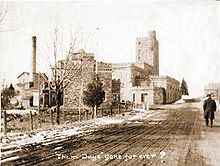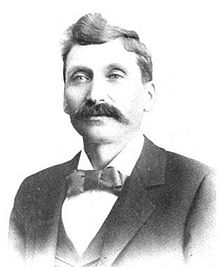Upper Peninsula Brewing Company Building
The Upper Peninsula Brewing Company Building is an office building at the intersection of Meeske Street and US 41 in Marquette , Michigan . Also known as Charles Meeske House , the building was the home and office of the brewer. Meeske was first the company's cashier and later became its president. The building was listed on the National Register of Historic Places on May 15, 1980 .
Description of the structure
The only building that remained from the building complex that was built in 1894 is Meeske's house and office. It is a two-story, rectangular building, which was built in the neo-Romanesque style from rough-hewn sandstone blocks of different sizes . The building has a stone chimney and crenellated parapets. The front entrance is set back under an arched portico . A cornice runs around the flat roof with the inscription UPBCo. wearing. A previously existing tunnel led from the building into the brewery , so that Meeske could get in unseen and ignore a law that prohibited entering breweries after sunset.
history
The German brewer George Rublein emigrated to the United States in the mid-19th century and arrived in Marquette in 1849, not long after the city was founded. Rublein founded the Franklin Brewery on the outskirts of Marquette. The brewery burned down twice, and in 1875 Rublein relocated to what is now the junction of Meeske Street and US Highway, near a water source Brewery renamed “Concordia Brewery.” Rublein built a number of buildings on the site and set up a beer garden based on the Bavarian model.
Rublein retired from the brewing business in 1879 and sold the brewery to Peter White. White, in turn, leased the business to two brewers from Milwaukee , Wisconsin , Charles Meeske and Reiner Hoch. The brewery flourished under their leadership. Within two years it turned out that the brewery could not meet the demand and so the two partners built a second brewery in Negaunee in 1881. From then on, Hoch took care of the plant in and Meeske managed the operation in Marquette. The following year they had made enough money to buy the Marquette facility from White. Meeske and Hoch founded a company, Hoch became its president and Meeske its chief financial officer, and two other men added to the board of directors.
In the 1890s, Meeske replaced the earlier timber-frame buildings with a complex of sandstone buildings whose appearance was modeled on small castles. The 42 acres (about 11 hectares ) large complex included warehouses, apartments, a tower and a bottling plant. Meeske kept the beer garden and gardens created by Rublein. The building on the corner of Meeske Street and US 41 was built in 1894 and serves as Meeske's apartment and office, but also as an entrance to the brewery premises.
In 1895 the brewery had an annual capacity of between 20,000 and 25,000 barrels of beer, which was sold under the brand name "Drei Kaiser". In the run-up to the outbreak of the First World War , the name was changed to "Castle Brew".
Local anti-alcoholic groups were putting pressure on the Marquette County's government to ban alcohol as early as 1916, four years before prohibition was introduced nationwide . When these ordinances were enacted, the Upper Peninsula Brewing Company stopped producing beer and the company was wound up; Meeske moved to Duluth , Minnesota .
After the Upper Peninsula Brewing Company ended, the stone buildings were used as a warehouse for a freight forwarding company. Eventually most of the buildings were abandoned and fell into disrepair. Meeske's residential and office building was used more. It served as a workshop and housed a law firm. Most of the unused buildings were demolished in 1974 and 1975, only the office building and a horse stable on Meeske Street remained. The Detroit and Northern Savings Bank offices were built on the property. Meskee's home was listed on the National Register of Historic Places in 1980. In 1982 it was bought by Humboldt Ridge and then restored.
Charles Meeske
Charles Meeske was born in Swinoujscie in Prussia in 1850 and learned the brewing trade under the guidance of his father. Meeske then did three years of military service in the army. Meeske emigrated to the United States in 1871 and settled in Oshkosh , Wisconsin for two years , where he worked as a foreman in a brewery. Meeske then went to Milwaukee , where he opened a brewery together with his brothers Gustav and Otto and the businessman Reiner Hoch.
After three years of partnership, Charles Meeske and Hoch bought out the other two partners and continued as Meeske & Hoch. Meeske married Amelia Heineman in 1876, with whom he had three children. Meeske and Hoch sold their Milwaukee brewery to a Chicago company in 1878 and moved to Marquette, where they took over the Upper Peninsula Brewing Company and bought a nearby mill. In addition to the brewery, Meeske was also involved in the Ishpeming Street Railway Company and Marquette Savings Bank, as well as a number of small mines. When Reiner Hoch left Marquette behind, Meeske took over the management of the company. After Marquette County issued prohibition regulations in 1916, Meeske moved to Duluth, where he worked with Reiner Hoch in his Duluth Brewing and Malting Company.
Pure high
Reiner Hoch was born near Cologne in 1851 , and a year later his family emigrated to America, where they settled in Waukesha County , Wisconsin. Hoch grew up on the family farm and went to college in Milwaukee when he was 18 to study commercial economics. After graduating, he decided to go into the beer bottling business. Then he became a partner in a brewery with Charles Meeske and his two brothers. Hoch married Mathilda Geele in 1878 and raised three children with her. In the same, he and Meeske went to Marquette to take over the management of the Upper Peninsula Brewing Company. Eventually, Hoch ran the company's branch in Negaunee.
Like Meeske, Hoch had other business activities including a furniture factory and the Negaunee and Ishpeming Street Railway. In 1896, Reiner Hoch moved to Duluth, Minnesota, where he founded the Duluth Brewing and Malting Company. The company also remained by the time of Prohibition and the Great Depression through active and was eventually led by Charles Meeskes son Carl.
Individual evidence
- ↑ National Register Information System (March 13, 2009)
- ↑ a b c d e f g h i j k Kim Hoyum: Brewery gone but not forgotten. Mining Journal, July 4, 2007, accessed January 31, 2010 .
- ↑ a b c d e Upper Peninsula Brewing Company Building. (No longer available online.) State of Michigan, archived from the original on June 6, 2011 ; accessed on January 31, 2010 (English). Info: The archive link was inserted automatically and has not yet been checked. Please check the original and archive link according to the instructions and then remove this notice.
- ↑ a b c d e f g h Memorial record of the Northern Peninsula of Michigan . Lewis Publishing Company, 1895, pp. 435-436 .
- ↑ a b c d e Memorial record of the Northern Peninsula of Michigan . Lewis Publishing Company, 1895, pp. 131-132 .
- ^ Alvah L. Sawyer: A history of the northern peninsula of Michigan and its people . The Lewis Publishing Co., 1911, pp. 768 .
- ^ Men of Michigan: a collection of the portraits of men prominent in business . Michigan Art Company, S. 370 (1904).
- ↑ a b c Doug Hoverson: Land of Amber Waters: The History of Brewing in Minnesota . U of Minnesota Press, 2007, ISBN 0-8166-5273-2 , pp. 217-218 ( google.com ).
- ^ Albert Nelson Marquis: The book of Minnesotans: a biographical dictionary of leading living men of the State of Minnesota . AN Marquis & Company, 1907, p. 234 .
Coordinates: 46 ° 32 '49 " N , 87 ° 25' 22" W.



